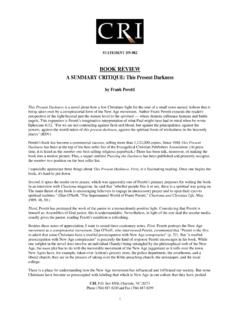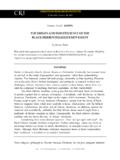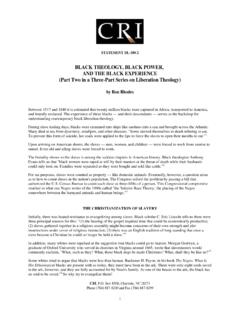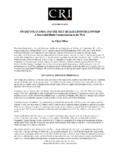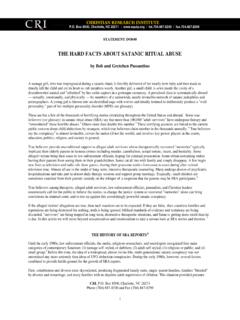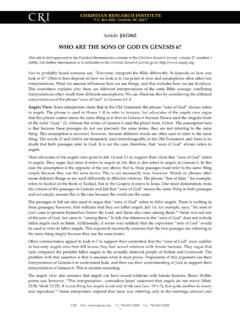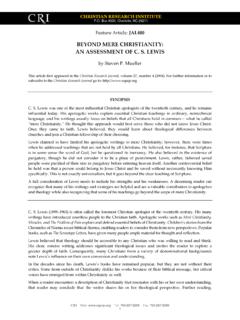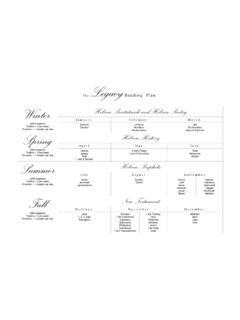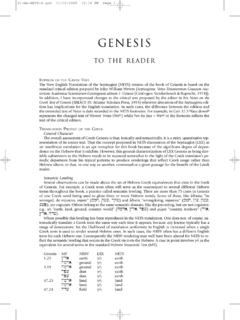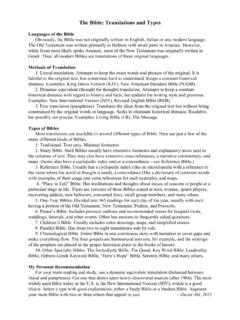Transcription of BIBLE VERSIONS: THE GOOD, THE BAD, AND THE UGLY (Part …
1 RESEARCH INSTITUTEPOBox8500,Charlotte, NC28271 Feature Article:JAB121-1 BIBLE VERSIONS: THE good , the bad , AND THE UGLY (Part One)byJames R. WhiteThis article first appeared in theChristian Research Journal, volume28, number3(2005). For further information or tosubscribe to theChristian Research Journalgo to: makes a BIBLE version good or bad and how can we tell the difference? The rapid increase inthe number of major English BIBLE versions over the past two decades places these questions front andcenter for many Christians. To answer them, one must understand the two schools of thought regardingtranslation. The first saysthat the goal of interpretation is to retain as much of theformof the originallanguage as possible.
2 This results in a more literal, word-for-word translation ( , KJV, NASB, ASV).The second says that the goal is to retain themeaningof the originaltext but not theform. This results in a freer rendering ( , NIV, NLT, CEV). The numerous English versions currently available lie along aspectrum between these two kinds of translation , although every version contains elements of both student of Scripture can gain insight into the biblical text by comparing versions from across thespectrum. The relationship of the translation of the BIBLE to the church is another issue of concern, giventhe amount of interpretation involved in those versions that do not retain the original form and the addedinterpretation and retranslation often involved in preaching.
3 The ideal situation is that the teaching eldersin a church be equipped to translate the text from its original language and to expound themeaning tothe , in His sovereign freedom, chose to reveal His Word to us in human language, and to do so inwritten form. He preserved His Word through the years so that it would continue to function as a lightand guide to its readersand hearers. His Word was delivered primarily in two languages:Hebrew, thelanguage of ancient Israel; andGreek, the language commonly used during the first century AD. Therevelation in the Old Testament was directly accessible to the Israelites.
4 It came to them in a languagethey understood within their own historical context. TheKoineor common Greek language of the NewTestament era allowed the Gospels to be read across the Roman Empire and allowed the letters of theapostles to be understood by the multicultural and multilingual churches to which they were sent. Theoriginal texts of Scripture were understandable to those who were living at the time they were problem that we face thousands of years later in English-speaking countriesis how to translate thoseancient texts so that they can speak and be understood today with the same power and meaning that theyhad originally. The issues surrounding the transmission and translation of the Scriptures remain amystery to many Christians today.
5 This is a dangerous situation in light of the frontal assault on theaccuracy and validity of the BIBLE in such popular works asThe Da Vinci Codeand in the media sfascination with such groups as the Jesus average believer just cannotafford to leave suchthings to the scholars; instead, he or she must have at least a basic understanding of how translation versions ( , translations1) of the BIBLE in English are good . Others are bad, and some aredownright ugly. Most people come to their conclusions as to which are good and which are bad withoutever considering the wide range of issues that go into answering the question, Is this a good Bibleversion?
6 I am asked constantly, Which is the most accurate version ? Those whowork in the translationfield know that answering that question is difficult, mainly because the one asking it probably has apredetermined definition of accurate that may or, in most cases, may not correspond to the reality ofthe task of we can discuss English BIBLE versions and where they fit in the spectrum of good , bad, anddownright ugly, we first must consider what it means to say a version is good . Only then can wemeaningfully discuss what would make a version bad, or, inthe case of cultic mistranslations of theBible, ugly.
7 FORM VS. FUNCTIONI like to use Jesus words in Luke 9:44 to illustrate the task we face in translating from one language toanother. Compare the rendering of the first clause of this verse in 11 major English versions in table 1:TABLE 1 BIBLE VERSIONTRANSLATION OF LUKE9:44 King James version (KJV)..Let these sayings sink down into your earsNew King James version (NKJV)..Let these words sink down into your earsAmerican Standard version (ASV)..Let these words sink into your earsNew American Standard BIBLE (NASB)..Let these words sink into your earsEnglish Standard version (ESV)..Let these words sink into your earsNew Revised Standard version (NRSV)..Let these words sink into your earsHolman Christian Standard BIBLE (HCSB).
8 Let these words sink inNew English translation (NET)..Take these words to heartNew International version (NIV)..Listen carefully to what I am about to tell youNew Living translation (NLT)..Listen tome and remember what I sayContemporary English version (CEV)..Pay close attention to what I am telling youThis table allows us to define terms and note important aspects of translation . It shows the spectrum, orcontinuum, that exists in modern English versions between two approaches to translation :formalequivalenceandfunction alordynamicequivalence. The goal offormal equivalenceis a more literal, word-for-word translation , whereas the goal offunctionalordynamicequivalenceis the communication of themeaningof the text but not necessarily the original form or wording.
9 Those versions that seek to maintainas much of theformof the original text as possible ( , to translate participles in Greek as participles inEnglish, even to the point of maintaining sentence structure) will render the phrase in Luke 9:44something like Let these words sink into your ears, as we see in the KJV, NKJV, ASV, and NASB. Twoversions that are in general further toward the middle of the spectrum, the ESV and NRSV, likewiserender it very formally. The HSCB remains fairly formal in its translation and the NET gives a morefunctional translation . Both versions provide translational notes. The HCSB note says the literal renderingis Put these words in your ears and the NET note says, Grk Place these words into your ears, anidiom.
10 The meaning is either do not forget these words ..or Listen carefully to these words. The NIV,which often sits squarely in the middle of the spectrum, gives a thought-for-thought translation a literal one. The functional or dynamic versions such as the NLT and CEV give the freest rendering as far as the original wording is 9:44 provides us with a chance to examine our selected versions further. Atthe end of the verse theLord says He is going to be delivered into the hands of men. Most of the versions keep this rendering,but some of those that differ include the NRSV ( human hands ), the CEV ( handed over to hisenemies ), and the NLT ( going to be betrayed ), which does not render the Greek word for men at we placed these 11 versions on a spectrum based solely on their rendering of the first phrase ofLuke9:44, they would fit roughly as follows in figure 1:Figure 1If we examined a large enough sample of passages, we could produce a fairly accurate analysis of wherethese versions fall.
